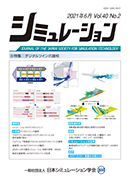Volume 13, Issue 2
Displaying 1-7 of 7 articles from this issue
- |<
- <
- 1
- >
- >|
Special Section on Student Papers
-
2021Volume 13Issue 2 Pages 48-58
Published: 2021
Released on J-STAGE: July 08, 2021
Download PDF (1952K) -
2021Volume 13Issue 2 Pages 66-72
Published: 2021
Released on J-STAGE: August 03, 2021
Download PDF (5119K) -
2021Volume 13Issue 2 Pages 73-82
Published: 2021
Released on J-STAGE: August 13, 2021
Download PDF (4677K) -
2021Volume 13Issue 2 Pages 83-91
Published: 2021
Released on J-STAGE: August 31, 2021
Download PDF (2973K) -
2021Volume 13Issue 2 Pages 92-101
Published: 2021
Released on J-STAGE: September 03, 2021
Download PDF (3216K)
Paper
-
2021Volume 13Issue 2 Pages 59-65
Published: 2021
Released on J-STAGE: July 28, 2021
Download PDF (4361K) -
2021Volume 13Issue 2 Pages 102-114
Published: 2021
Released on J-STAGE: November 10, 2021
Download PDF (1717K)
- |<
- <
- 1
- >
- >|
